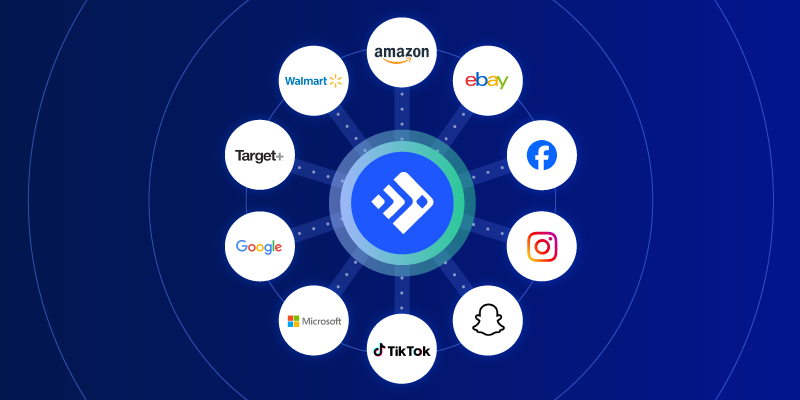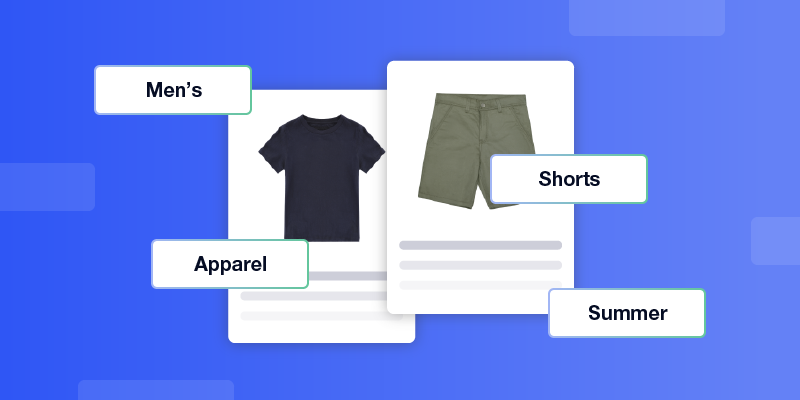Today’s shoppers connect with brands across multiple touchpoints before making a purchase, and Amazon and Walmart are two of the most popular starting destinations for product searches. That’s just one of the many reasons why adding online marketplaces to your channel mix is a great way to expose your products to more customers and increase your revenue streams.
However, merely listing products on a marketplace doesn’t guarantee success. In this blog, we show you what it takes to win on the world’s top marketplaces, with help from our partners at ROI Revolution and BigCommerce.
By “winning,” we mean optimizing your listings to reach valuable customers, strengthening your brand presence, streamlining order management, and tackling common marketplace challenges that hold you back. We also highlight opportunities in the marketplace space and show you how to leverage powerful tools for ecommerce success.
When we say marketplaces, we’re referring to channels where transactions and product discovery happen on the same platform. This includes traditional marketplaces like Amazon, Walmart, and eBay, as well as niche marketplaces like Macy’s, Kohl’s, and The Bay.
Some social commerce channels also have native checkout capabilities, but we have a separate blog dedicated to those shopping destinations.
This marketplace blog is the first in a series that includes contributions from industry experts about how to win on a variety of shopping destinations:
How to win on online marketplaces
Building your brand
Strong branding is crucial for standing out and capturing the attention of potential customers. It not only differentiates a product from its competitors, but also builds trust and loyalty among shoppers. By consistently presenting a cohesive brand story across various platforms, brands can enhance their visibility and appeal.
Leveraging the unique tools and features offered by each marketplace can further amplify a brand’s presence and effectiveness.
“Amazon provides helpful new-to-brand metrics across all ad types, with the exception of Sponsored Products. Amazon’s ad platform, Amazon DSP, allows you to measure the impact of your display campaigns with the ability to track branded searches. This is helpful when looking at new customer acquisition costs and if you are shifting from awareness to brand consideration.”
Take advantage of a dedicated storefront to showcase your brand. These are spaces for you to create a more customizable branded experience for your customers, where you can spotlight products, add images, and tell your story. These storefronts also allow customers to search through all your products from one central location. According to Amazon, brands with a store see 31 times more repeat purchases within 60 days.
Protect your brand’s IP and reputation. By registering your trademarks with marketplaces, you can unlock special brand-building tools, and gain more control over product listings that feature your brand’s products. For example, by registering your brand on Amazon you gain access to the Amazon storefront, Amazon Live, and brand monitoring tools.
Get more customer reviews with programs that enable you to encourage customers to review select products—like Walmart’s Review Accelerator—or by sending your products to a pre-selected network of reviewers, such as Amazon Vine.
Enhance your content and set yourself apart from other sellers with more customizable product pages that give you access to features like 3D models or dedicated brand story sections. Rich, structured content is especially important as AI-driven product discovery tools scan listings for signals of quality and relevance—key considerations for any effective AI ecommerce strategy.
Try out live shopping, where influencers talk about products they love. It’s kind of like late-night infomercials or QVC, except there are in-video links that take customers directly to the product listing or checkout page.
Here are a few more tips to make your brand stand out:
- Ensure that your brand store reflects your brand’s identity consistently. This includes using your brand’s logo, colors, fonts, and imagery.
- Storytelling can be a powerful tool; share the history of your brand, your mission, and what makes your products unique.
- Create engaging and informative content by using videos, infographics, and detailed product descriptions.
- Showcase your products with clear, detailed photos from multiple angles. Include lifestyle images that show your products in use to help customers envision the products in their own lives.
- Use the Q&A section to promptly respond to customer questions.
Winning the buy box
If multiple sellers list the same product on a marketplace, their listings can be grouped together. When this happens, one seller’s offer may be prominently displayed over the rest on the product page. We can say that that seller has “won the buy box” or “Featured Offer,” as it’s now known on Amazon.
Bonus tip from our feed specialists:
eBay doesn’t have a buy box, even for sellers that list the same item. Instead, sellers have independent product pages. Target Plus, on the other hand, only allows one seller per barcode, which means sellers won’t ever compete for the same listing.


Having the Featured Offer, or winning the buy box, can greatly increase a seller’s visibility and sales potential.
Amazon’s Featured Offer is determined by factors like price competitiveness, seller performance metrics (order defect rate (ODR), cancellation rate, late shipment rate), fulfillment method, and inventory availability. Multiple sellers can compete for the Featured Offer, and it rotates among eligible sellers.
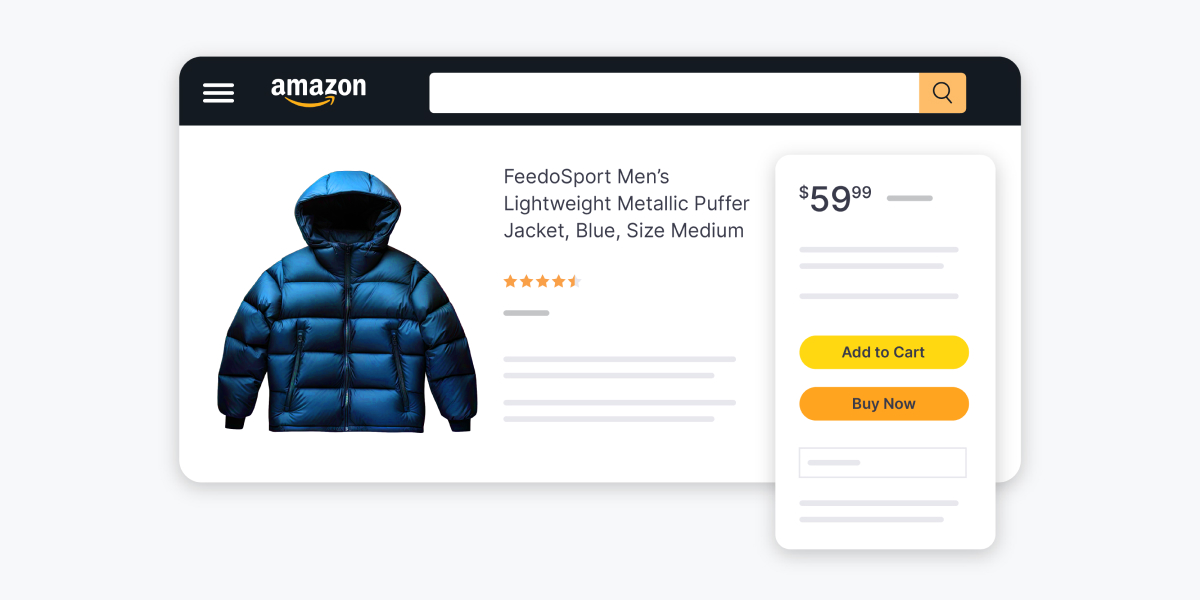
Walmart’s buy box prioritizes price and shipping speed. Sellers with the lowest prices and fastest shipping options are more likely to win the buy box. Walmart also considers the seller’s performance metrics and recommends tools like Repricer to help retailers win the buy box.
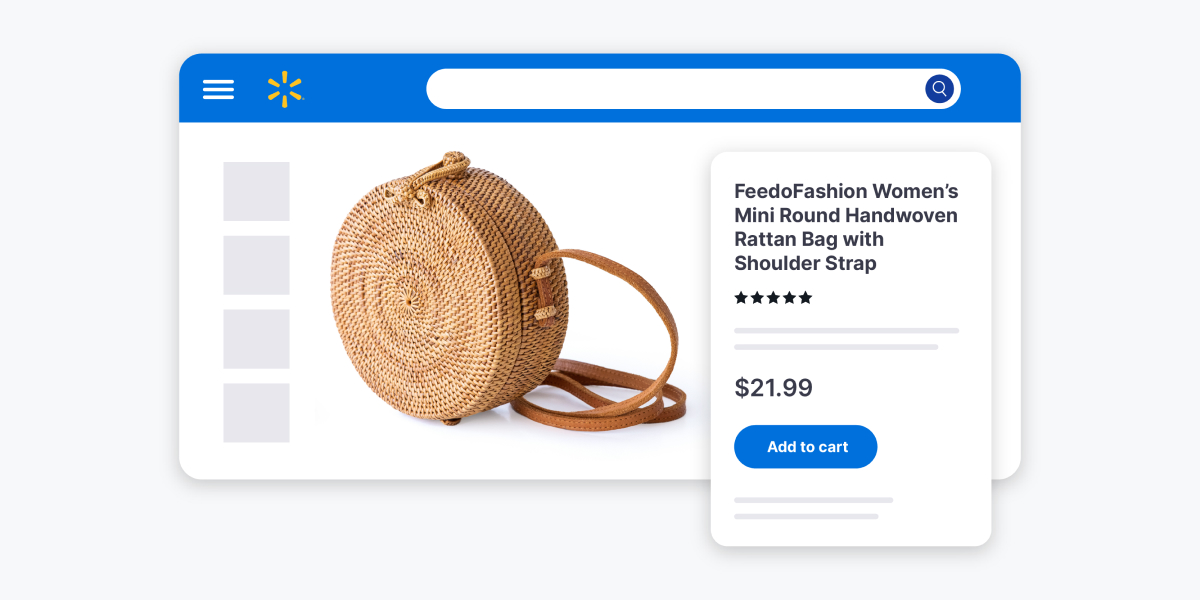
Optimizing your product data
“Shoppers respond when products are listed with plenty of rich content and accurate details.”
You can’t take raw catalog data like titles and descriptions, make minimal changes to them, and expect your product listings to perform well on marketplaces.
To appear in search results and next to related items, you need accurate, optimized, and complete listings.
Each marketplace has specific requirements for submitting a product feed. And if you want your business to be scalable, you should be submitting product feeds rather than uploading or creating products manually.
Here are some data optimization tips to help you squeeze more value out of your listings:
Product images
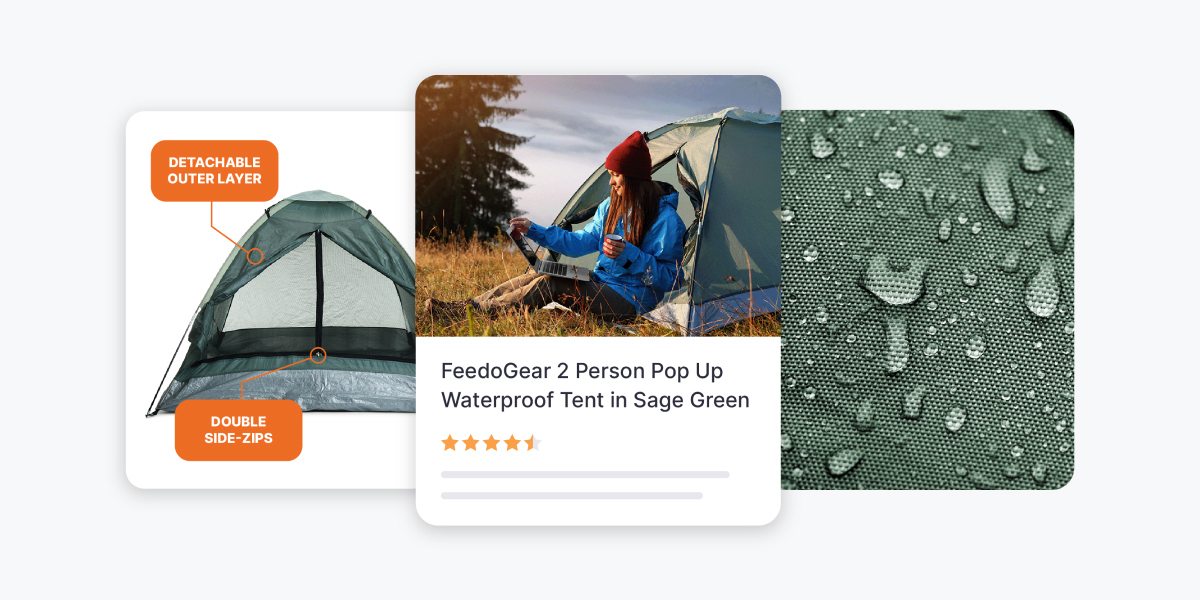
Product images are central to winning on marketplaces because online shoppers rely on them to understand what they’re getting.
Most channels require a minimum image resolution and main product images to be featured on a white background.
To up your image game and give customers more context, you should think about taking advantage of zoom-in shots to show the product’s details, lifestyle images to tell a story or show your product in use, and infographics that highlight your product’s unique selling point, dimensions, or competitor comparisons.
Titles

The basic structure of a good title is fairly consistent across marketplaces. It typically starts with the brand, followed by the product model or name, followed by any relevant product nouns or features, including variant information like sizes or colors.
Include enough information for a shopper to make the purchase based on the product title alone. Of course, most customers look at the full product listing and not only the title, but a good product title is key to creating a positive first impression in the search results. You don’t need to completely overload your titles with information.
Remember that you should use bullet points and descriptions to go into more detail about your product. A product listing title with too many characters can look spammy and unprofessional, and erode trust in your listings.
Check out our Amazon product title examples to see what kind of information you should and should not include, and how titles vary by product category.
Descriptions and bullet points
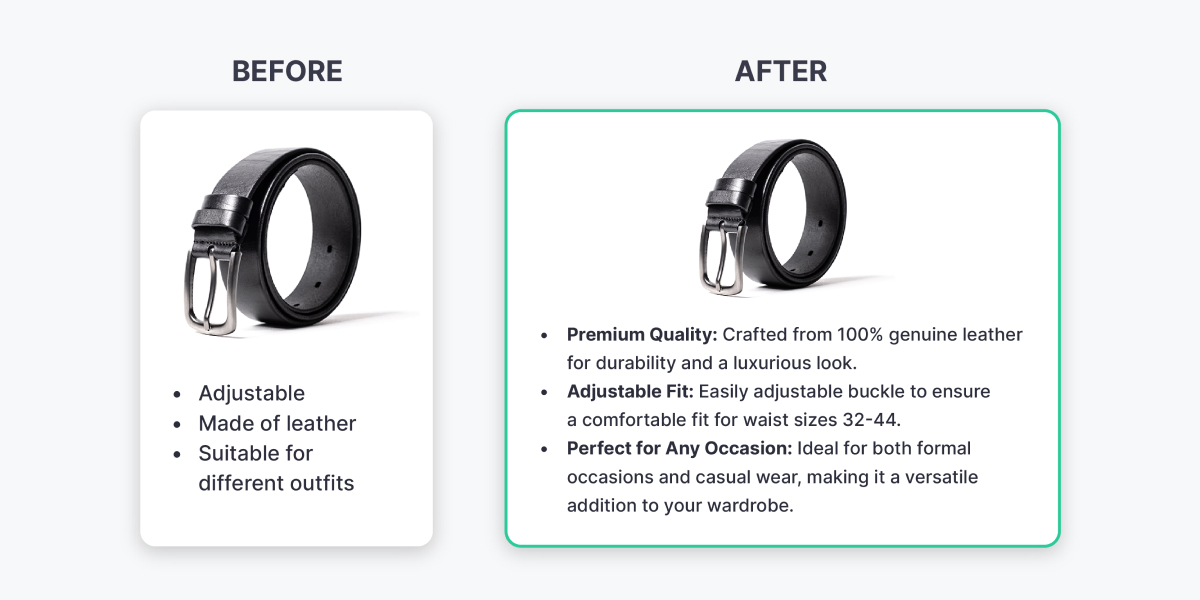
Listings usually have a section specifically for bullet points. Here’s how to optimize those:
- Start with the most critical features. Each bullet point should focus on a unique benefit or feature of the product.
- Use clear, concise language that gets to the point quickly.
- Include relevant keywords in a way that reads naturally.
- Include sizes, materials, compatibility information, etc.
- If your product has a unique selling point, such as being reusable or biodegradable, ensure it’s prominently mentioned.
If you don’t have individual features for every product, a great tip is to use a detail that is true for all your products of a particular type and apply it to the entire catalog, such as “100% organic cotton.”
Bonus tip from our feed specialists:
Target Plus, Macy’s, and Kohl’s typically have more stipulations about how a product should be represented on-site, including formatting rules for titles, bullet points, and descriptions. Target Plus also requires that environmentally-sensitive products are WERC registered.



For your product descriptions, it’s important to make sure you meet the character limits of the marketplace, you correct typos and formatting errors, and you apply the following best practices:
- Use the product description to weave a narrative that includes the product’s benefits and features.
- Expand on the information given in the bullet points. Provide more in-depth details about the product, its usage, and any additional features not covered.
- Ensure your descriptions are easy to read, with short paragraphs and extra spacing.
As always, periodically review and update your descriptions and bullet points to reflect customer feedback and changes in your product.
Categorization
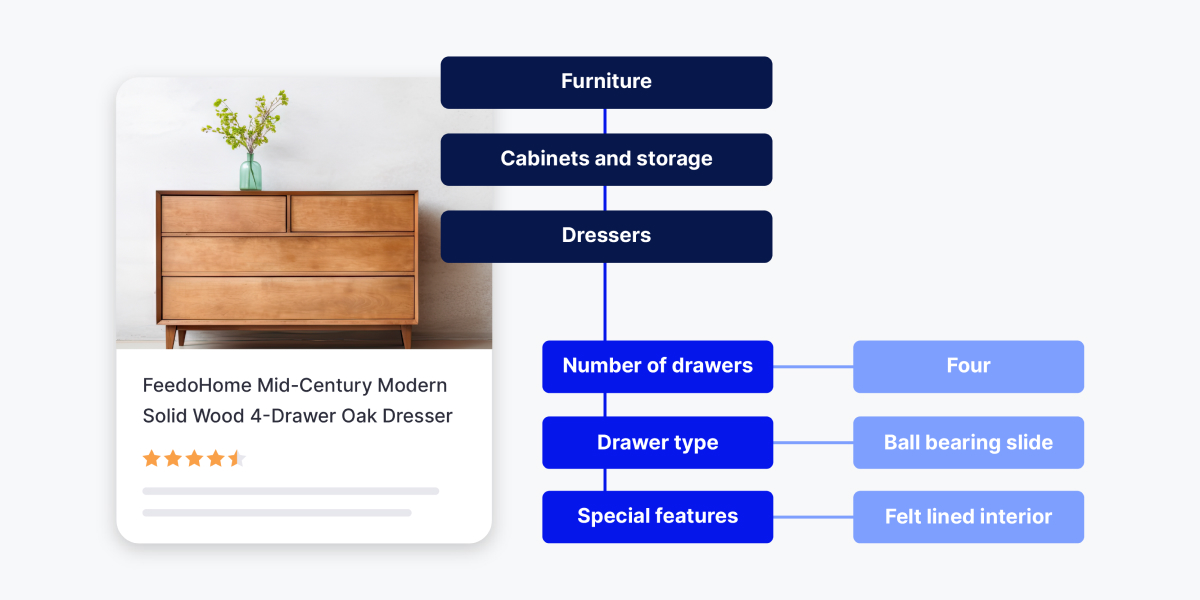
Ensure products are not just broadly categorized, but are assigned to the most specific categories available on a marketplace.
Bonus tip from our feed specialists:
Amazon has some of the most granular categorization options compared to other marketplaces.

For example, a high-end home decor seller doesn’t want its dressers to be categorized simply as “furniture,” or even the slightly more specific “cabinets and storage.” The best categorization gets down to the most granular level, “dressers.”
This granularity enables the product listing to appear for more specific searches, filtered results, and alongside “related products” sections that are common to marketplaces. It also does something extremely important for improving the quality of your listings: it unlocks structured, unique fields for showcasing product details specific to dressers, such as the number of drawers, drawer types, and more.
Populate optional attributes
The more information you give marketplaces about your products, the better they can match them to relevant customers.
Take the previous example. If the seller didn’t specify the number of drawers in their dressers, customers would not be able to find the dressers when filtering, and the dresser would be less likely to appear when customers are looking at other dressers with six drawers.
Leverage feed management technology
If you have a large product catalog, or want to sell on multiple marketplaces, manually optimizing each SKU’s title, description, category, and other attributes just isn’t feasible.
A feed management platform automates listing optimization with custom rules that format product data in bulk and apply optimizations across catalogs for any or all channels.
For example, you could optimize the product titles for your blouses using a data transformation formula similar to this:
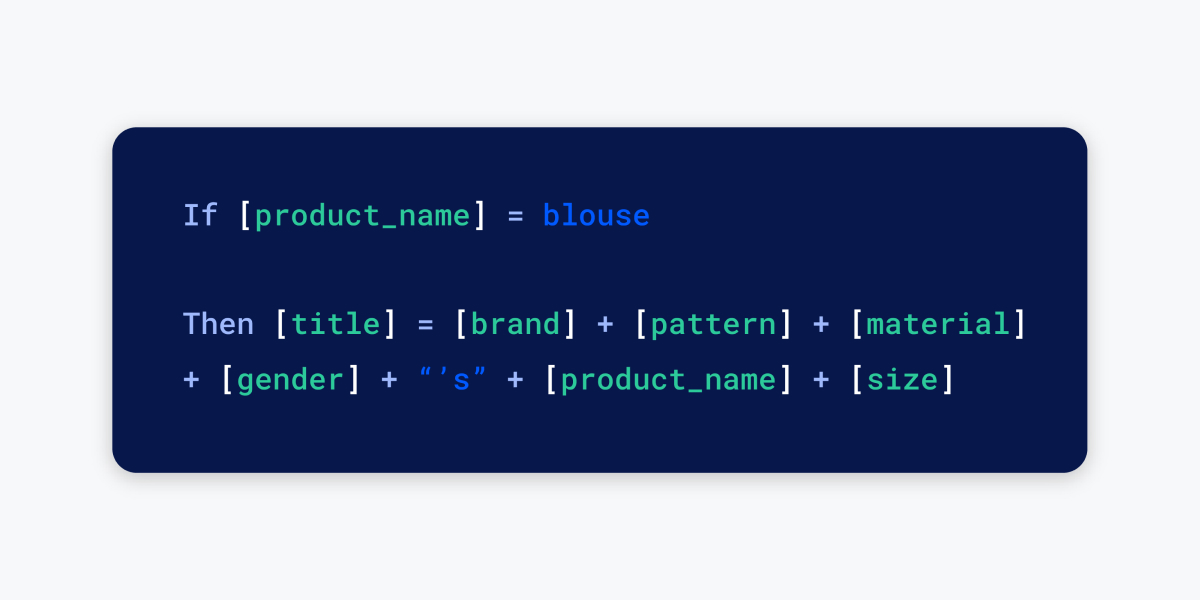
The platform then parses the values from each bracketed attribute and generates uniform, easy-to-read titles for all blouses across the channel catalog:

Feed management platforms can also provide image padding services, which makes it easier for you to get all of your product images to meet the specifications of the marketplaces you want to sell on without having to retake photos or manually edit each one.
This is especially useful to sellers who already have a database of product images that were not taken with marketplace requirements in mind—like manufacturers with large catalogs of small parts and pieces.
Getting your fulfillment right
It’s important to have a streamlined fulfillment process when you’re selling on marketplaces, but it can get tricky managing orders if you’re selling on more than one channel.
Ensuring that orders are processed correctly and on time will reduce the number of customer returns you get, increase customer satisfaction, reduce negative reviews, and ensure you stay within a marketplace’s accepted order defect rate.
Integration and automation
To reduce the manual effort and errors involved with pulling order data, processing orders, and updating fulfillment information, you should seek out a feed provider that also has automated order management technology. This technology works in conjunction with your order management system and other fulfillment solutions to integrate directly with the marketplaces you sell on.
Setting up inventory buffers helps prevent order delays caused by overselling. By displaying less stock than is actually available and reserving a custom quantity, you can reduce the risk of having to cancel orders due to stock shortages. This especially comes in handy during peak shopping seasons or when you’re running promotions that can quickly deplete your stock before your inventory is synchronized.
Customer feedback and reviews
Pay close attention to customer feedback and reviews, because they can often reveal opportunities for improvement in your product listings and offerings. For example, if customers are saying that your apparel “runs big,” then you should update your sizing guide. These adjustments help reduce return rates and improve overall customer satisfaction.
What’s next for online marketplaces?
Winning isn’t just about tackling today’s challenges, it’s also about future-proofing your operations. Here are the ecommerce trends you should keep an eye on as you refine your marketplace strategy:
The growth of retail media
“We’re seeing new retail media networks emerge every six months or so and expect this to continue given the value of harnessing your first-party data into insights for growth and expansion.”
Marketplaces like Amazon, Walmart, and Target Plus have been steadily growing their advertising capabilities. These retail platform ad features are called retail media networks, and they’re becoming a powerful way for brands to boost their performance within a given marketplace. They enable sellers to increase visibility for specific products and appear in search results or product detail pages, or leverage a platform’s data to retarget to users externally.
For example, Walmart has pay-per-click sponsored search ads, which allow you to promote a specific product, brand, or video. Similarly, Amazon offers sponsored product, brand, and display ads.
“TACoS, or Total Advertising Cost of Sale, is a tried-and-true measure of success, looking at your advertising costs against total sales to see if your growth rate is continuing to increase as your advertising investment increases.”
Some of these retail media networks come with deep marketing tools that allow you to benefit from the data they collect from customers who already shop on the platform. For example, with Amazon sponsored ads, you can set up segments to re-engage customers who have shown interest in your product but did not make a purchase, and display relevant products to users based on their Amazon browsing history.
It might make sense for your business to begin designing campaigns specifically for retail media network advertising, like creating eye-catching sponsored videos that quickly communicate your product’s unique selling point.
“Amazon has more opportunities to refine your audience off the channel as much as on, so take advantage of those. We know customers are searching on marketplaces with initial research as much as they are to make their final purchase selection.”
More omnichannel integration opportunities
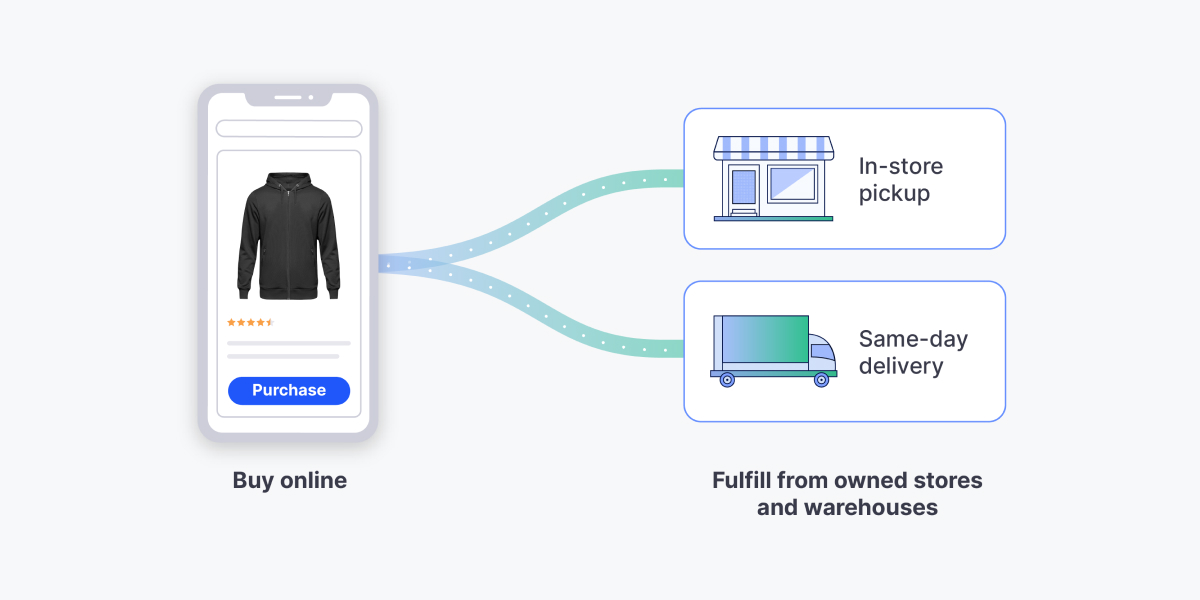
Marketplaces have also taken huge leaps in omnichannel integrations in recent years, and we expect this trend to continue.
Amazon, Walmart, and Target have invested heavily in same-day delivery and buy online, pick up in store (BOPIS) integrations, which offer even more convenience to customers who want products fulfilled quickly.
“It may feel surprising to call Walmart ‘up-and-coming,’ but the marketplace still has tremendous potential for growth. It has the BOPIS benefit, and as the company builds out its retail media platform, our customers have seen a very healthy impression share compared to their initial investment on the channel.”
Brands can use their brick-and-mortar stores as distribution centers, and they can partner with marketplaces or other delivery services to have their products delivered quickly without having to build out fully-fledged fulfillment networks of their own. Some marketplaces even allow you to deliver products with your branding on the packaging.
With BOPIS, customers can see and purchase your products on marketplaces and then pick them up in the store. This feature helps brands increase foot traffic to their retail locations, drive more in-store purchases, and bring customers into their loyalty and rewards programs.
These kinds of integrations are facilitated by partnerships with platforms like Feedonomics, which enable you to synchronize your in-store inventory and product data with the marketplaces you list on so that your stock, pricing, and other listing information is updated in real time.
Feedonomics can help you win on marketplaces.
Online marketplace strategies FAQs
How can I improve the user experience on my marketplace listings?
To improve user experience on your marketplace listings, focus on clear, detailed product information. Use high-resolution images that showcase the product from multiple angles, and include lifestyle shots where appropriate. Titles and bullet points should be scannable and informative, while descriptions should offer deeper insights into product features and benefits.
Don’t forget the importance of accurate categorization and attributes—these directly affect discoverability and filtering. Consistently updating listings based on customer feedback, reviews, and performance data helps build trust and ensures that your content remains relevant. A polished, informative, and easy-to-navigate listing improves both customer satisfaction and conversion rates.
How does social media impact marketplace performance?
Social media can significantly influence marketplace performance by driving external traffic to your listings and increasing brand visibility. Platforms like Instagram, TikTok, and Facebook give you a great opportunity to showcase products in real-world scenarios, connect with potential customers through storytelling, and create buzz through influencer partnerships or live shopping events.
When used strategically, social media can complement your digital marketing and overall online marketplace strategy by nurturing your target audiences outside the platform and guiding them toward conversion. Sharing user-generated content, reviews, and behind-the-scenes footage can enhance brand authenticity and reinforce your value proposition. Over time, this engagement can lead to higher brand recall, increased traffic, and improved performance across ecommerce marketplace channels.
Is SEO important for marketplaces?
SEO is crucial for success on marketplaces because each platform has its own internal search algorithm that determines which products appear at the top of search results. Optimizing your product titles, bullet points, descriptions, and attributes with relevant keywords increases your listings’ visibility, helping you reach more potential customers.
Unlike traditional search engines, marketplace SEO also depends on performance signals like conversion rates, fulfillment speed, and customer reviews. To stay competitive, regularly audit your listings for keyword relevance and make iterative improvements based on what your target audience is actually searching for. A strong SEO foundation is essential for long-term discoverability and sales growth.
What role does inventory management play in marketplace success?
Effective inventory management ensures that your product listings remain accurate and available, reducing the risk of overselling, delayed shipments, or stockouts—all of which can negatively impact your seller performance metrics. Marketplaces reward reliable sellers with better placement in search results and a higher chance of winning the buy box, making inventory accuracy a key driver of visibility and sales.
Automated inventory syncing across channels allows you to streamline operations and prevent costly fulfillment issues, especially when running promotions or managing seasonal demand.
How can I differentiate my brand in a crowded marketplace platform?
To stand out in a crowded marketplace, start with a clear and compelling value proposition. Use branded storefronts, enhanced content like Amazon A+ or Walmart Rich Media, and high-quality imagery to showcase your products and communicate what makes your brand unique. Consistency across your product listings—logo, tone, visuals—helps reinforce brand recognition and build trust with shoppers.
Beyond aesthetics, focus on delivering a superior customer experience. Offer detailed, accurate product information, highlight key differentiators, and respond promptly to questions or reviews.
Over time, these efforts establish credibility and loyalty, making your listings more competitive and resilient against price-driven competitors.
What are some effective ways to build trust with customers on marketplaces?
Building trust starts with creating professional, accurate, and high-quality listings. Include clear product images, detailed descriptions, and transparent shipping and return policies. Ensure your branding is consistent across listings and take advantage of tools like Amazon Brand Registry or Walmart’s Brand Portal to protect your brand identity and reduce the risk of unauthorized third-party sellers.
Customer interactions also play a major role. Promptly answering questions, addressing negative feedback, and encouraging reviews through post-purchase emails or marketplace programs (like Amazon Vine or Walmart Review Accelerator) help establish credibility.
Over time, consistently positive customer experiences will lead to higher ratings, repeat purchases, and increased visibility.
How do I know if a new marketplace is right for my business goals?
Before expanding to a new marketplace, assess whether its customer base aligns with your target audience and if the platform offers the functionality your business needs—such as support for your fulfillment model, integration with your tech stack, or access to advertising tools. Analyze your current performance data and define clear objectives to ensure the move supports your broader business goals.
It’s also important to understand the pricing strategies that dominate the marketplace and how your products fit within that landscape. Some platforms cater to value-driven shoppers, while others support premium positioning.
Make sure you understand the marketplace’s pricing models (like any referral fees, listing fees, or payment processing fees) and look into the pain points of other sellers in your niche, like margin pressure or price wars.
What retention strategies work best for marketplace sellers?
While marketplaces don’t offer the same direct relationship with customers as owned channels, retention is still possible through exceptional customer experience. Fast, accurate fulfillment, thoughtful packaging, and proactive support all contribute to positive reviews and repeat purchases. Leveraging features like branded storefronts and enhanced content can keep shoppers engaged and increase loyalty.
Some marketplaces offer tools like follow-up messaging or brand engagement metrics that help sellers understand buyer behavior. By using these insights to improve listings and exceed expectations, you create brand stickiness.
What are some marketplace tips for startups?
For startups, marketplaces offer a fast, lower-barrier way to test new products, generate early revenue, and validate demand. Start by choosing platforms that align with your target audience and business model, and prioritize strong product data and fulfillment reliability. Early mistakes—like poor inventory planning or vague listings—can hurt visibility and credibility, so invest in getting the fundamentals right.
As a startup scales, marketplace performance data can also help with broader business planning: insights into conversion rates, pricing pressure, and customer preferences can guide product development, marketing strategies, and inventory investments.
How do curated experiences help brands stand out on marketplaces?
Platforms like Amazon and Walmart offer tools to create curated pages or highlight collections, giving you a chance to guide customers through a branded shopping journey. Done well, this increases engagement and enhances the user experience, ultimately boosting conversion and elevating your overall brand presence within the marketplace ecosystem.
When integrated with broader marketing efforts and marketplace strategies, curated content supports both differentiation and long-term success.

Muhammed is a content marketing specialist creating informative content to help ecommerce professionals solve industry challenges and stay ahead of the curve.



